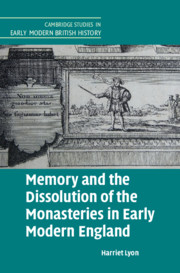Book contents
- Memory and the Dissolution of the Monasteries in Early Modern England
- Cambridge Studies in Early Modern British History
- Memory and the Dissolution of the Monasteries in Early Modern England
- Copyright page
- Dedication
- Contents
- Figures
- Acknowledgements
- Note on the Text
- Abbreviations
- Introduction
- Chapter 1 ‘No News but the Abbeys Shall Be Down’
- Chapter 2 ‘Worthy of Lasting Memory’
- Chapter 3 ‘Raised Out of the Ruins’
- Chapter 4 ‘Many Pretty Odd Tales’
- Conclusion
- Bibliography
- Index
Chapter 1 - ‘No News but the Abbeys Shall Be Down’
Reform, Surrender, and Suppression in the 1530s and 1540s
Published online by Cambridge University Press: 08 October 2021
- Memory and the Dissolution of the Monasteries in Early Modern England
- Cambridge Studies in Early Modern British History
- Memory and the Dissolution of the Monasteries in Early Modern England
- Copyright page
- Dedication
- Contents
- Figures
- Acknowledgements
- Note on the Text
- Abbreviations
- Introduction
- Chapter 1 ‘No News but the Abbeys Shall Be Down’
- Chapter 2 ‘Worthy of Lasting Memory’
- Chapter 3 ‘Raised Out of the Ruins’
- Chapter 4 ‘Many Pretty Odd Tales’
- Conclusion
- Bibliography
- Index
Summary
Chapter 1 examines the process of suppression in the 1530s, using memory as a tool for rethinking our approach to this episode. With sensitivity to the language employed by the Henrician government, it characterises the dissolution as a long and uncertain process that can be separated into two main phases: the ‘reformation of the monasteries’ and the ‘surrender of the monasteries’. It pays particular attention to the emergence of narratives of monastic corruption and the expediency of suppression because, it argues, these are the themes that modern scholarship has inherited from its largely Henrician source base. It is the success and longevity of this triumphalist narrative that the remainder of the book sets out to test, complicate, and unravel. This chapter also notes the emergence of early critiques of the dissolution – Catholic, conservative, and evangelical – which are traced alongside the narratives propagated and perpetuated by Tudor governments with a view to highlighting the complexity and diversity of the early modern memory of the dissolution. Crucially, the chapter highlights the prevalence and persistence of the idea that the monasteries were irredeemably corrupt across different confessional perspectives, as well as across time and space.
Keywords
- Type
- Chapter
- Information
- Publisher: Cambridge University PressPrint publication year: 2021

